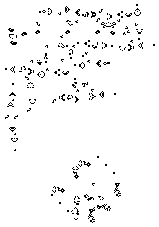Sawtooth 1163
Sawtooth 1163 is an orthogonal sawtooth with external timing so that its repeated minimum population generations don't come quite at fixed exponential gaps like most sawtooths. It was found by David Bell on October 27, 1992. Its minimum repeating population is 1163.
| Sawtooth 1163 | |||||||
| |||||||
| View static image | |||||||
| Pattern type | Sawtooth | ||||||
|---|---|---|---|---|---|---|---|
| Number of cells | 1249 | ||||||
| Bounding box | 150×219 | ||||||
| Expansion factor | n/a | ||||||
| Discovered by | David Bell | ||||||
| Year of discovery | 1992 | ||||||
| |||||||
This sawtooth works by sending blinker puffer 1, a period 8 blinker puffer found by Robert Wainwright westward. A glider bounces between a fixed reflector in generations 480(2n) - 701 (n ≥ 1) and a southeastward Cordership in generations 720(2n) - 661 (n ≥ 1). Each bounce from the fixed reflector releases a salvo (formed in generations 480(2n) - 310 (n ≥ 1)) consisting of a middleweight spaceship and two lightweight spaceships aimed toward the line of blinkers. The salvo hits the nearest blinker in generation 2400(2n - 880n - 3115 (n ≥ 1), causing a blinker fuse to form and burn at 2c/3 (another salvo, present in the initial pattern, hits the blinker line in generation 5). When the decay catches up to the puffer, a new line of blinkers starts to form in generations 3840(2n) - 880n - 3760 (n ≥ 0).
When the salvo hits the blinker line, the total population is large (about 180(2n) in generations around 2400(2n). In generation 2400(2n) - 880n - 3115 there are 60(2n) - 29 blinkers. When the decay catches up with the puffer, the population is bounded below 1200 in generations around 3840(2n) - 880n. More specifically, if n = 0 then the population reaches a low of 1158, if n = 1 (mod 3) then the population reaches a low of 1183, if n = 2 (mod 3) then the population reaches a low of 1163, and if n ≥ 3 and n = 0 (mod 3) then the population reaches a low of 1187.
Image gallery
 The number of alive cells plotted versus the number of elapsed generations roughly forms an ever-increasing sawtooth graph.
The number of alive cells plotted versus the number of elapsed generations roughly forms an ever-increasing sawtooth graph.
See also
External links
- Sawtooth 1163 at the Life Pattern Catalog
